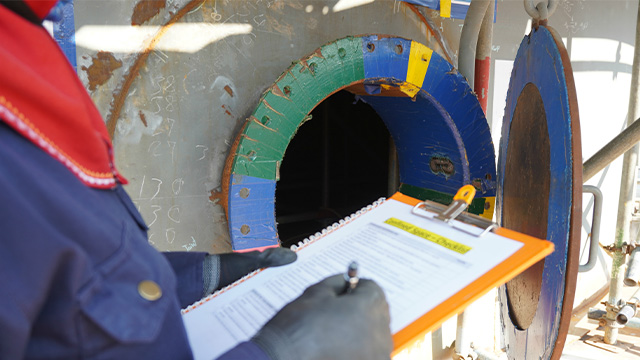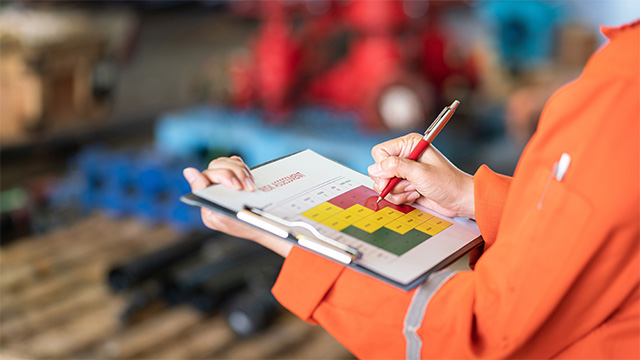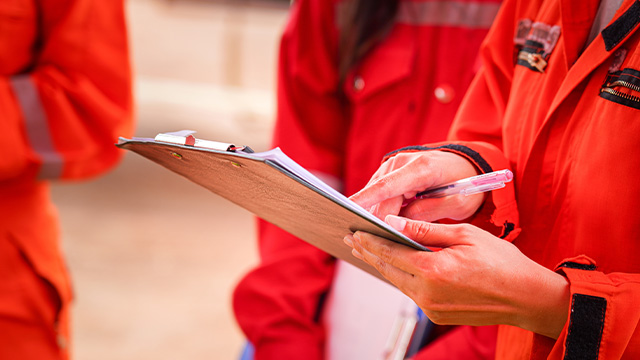Risk assessments are the cornerstone of maintaining a safe and secure workplace. These assessments not only identify potential hazards but also evaluate associated risks and develop strategies to prevent issues from occurring, and save lives.
This blog post will guide beginners to navigate risk assessments, their importance, step-by-step processes, and their role in fostering a workplace safety culture.
Understanding Risk Assessments
What is a Risk Assessment?
A risk assessment is a structured process designed to identify, analyse, and mitigate potential hazards that could harm people, property, or the environment. Not only is this ongoing process vital for the well-being of employees, but it is also often required by workplace safety regulations to ensure adherence to legal standards.
In essence, risk assessments measure the magnitude of potential dangers and define what preventive measures or controls should be implemented to mitigate the likelihood of these hazards causing harm.
Risk Assessment Process
The risk assessment process involves several steps that aim to identify potential hazards, assess the risks associated with those hazards, implement control measures to reduce the risks, and review existing control measures to ensure they are effective. The steps involved in the risk assessment process are as follows:
1. Hazard Identification
Firstly, it begins with identifying hazards. This includes spotting potential workplace harm sources, which can stem from physical, chemical, biological, ergonomic, and psychosocial factors.
2. Risk Analysis and Evaluation
The next step is to evaluate the risks. This involves determining the severity of the possible harm and the likelihood of its occurrence. Risks are typically assessed on a scale to determine their significance and prioritise them for control measures.
3. Risk Control
Once risks are identified and evaluated, the third step is to implement control measures. These include strategies aimed at mitigating the identified risks. Control measures can range from engineering solutions (like machine guards or improved ventilation), administrative controls (implementing control measures such as rotating jobs or scheduling regular breaks), to the use of Personal Protective Equipment (PPE).
4. Documentation and Record-Keeping
Documenting the risk assessment process, including the identified hazards, risk analysis, evaluation, and control measures implemented is essential. This documentation serves as a record of compliance and helps monitor and review the effectiveness of the implemented control measures.
5. Review Control Measures
The final step is to review and monitor the effectiveness of the control measures. Effective risk assessment is not a single occurrence but an ongoing and continuous process. Regular reviews ensure that the control measures remain effective, especially in light of any changes in work processes, introduction of new machinery or substances, or in response to accidents or near misses.

Types of Risk Assessment
In Australia, risk assessments are used across various sectors, each with unique types and methods. Here are some of the types of risk assessments utilised:
- Workplace Risk Assessment: This involves identifying hazards in the workplace, assessing the risks associated with these hazards, controlling these risks, and reviewing control measures. It applies to all workers and industries and can include risks such as chemical exposure, machinery, ergonomics, etc.
- Business Risk Assessment: Businesses use risk assessments to plan and manage risks that could affect their operations. These assessments help businesses understand potential risks, prioritise them, and take appropriate action to reduce them.
- Health Risk Assessment: Risk assessments help understand and manage environmental health risks in the health sector. They introduce the reader to the basic concepts of health risk assessment and provide a tool for assessing and managing such risks.
- Financial Risk Assessment: AUSTRAC, the Australian Transaction Reports and Analysis Centre, employs risk assessments to analyse prevalent threats of money laundering and terrorism financing. This method identifies and addresses specific vulnerabilities within different sectors of Australia's financial industry.
- Child Protection Risk Assessment: In child protection practice, risk assessment instruments are used to identify and manage risks to children's safety and well-being.
- Human Health Risk Assessment: Human health risk assessments evaluate the potential risks to human health from environmental hazards. Professionals with qualifications in science, engineering, or medicine typically conduct these assessments. This process involves collaborating with toxicology, epidemiology, and chemistry experts to ensure accuracy and comprehensive analysis.
- General Risk Assessment: The risk management process outlined by Safe Work Australia involves identifying hazards, assessing risks, controlling risks, and reviewing control measures. This type of risk assessment is applicable across various industries and helps organisations respond to change and improve safety.
Importance of Risk Assessments
Risk assessments are crucial in ensuring workplace safety and have several significant benefits. Here are the key reasons why risk assessments are essential:
Accident prevention
Risk assessments form the bedrock of accident prevention. They help identify potential hazards and risks in the workplace, raising awareness about them and enabling proactive measures to prevent accidents and injuries.
Compliance with regulations
Employers have a legal responsibility to protect workers and safeguard the well-being and security of their employees. Risk assessments aid organisations in meeting health and safety regulations while showcasing their dedication to fostering a secure work atmosphere.
Hazard recognition and control
Risk assessments empower organisations to identify and manage workplace hazards effectively. By pinpointing potential sources of harm, injury, or adverse health effects, organisations can proactively implement appropriate control measures to mitigate risks and control hazards.
Employee awareness and training
Risk assessments create awareness among employees about the hazards and risks present in the workplace. They can be used as a training tool to educate employees on potential dangers and the necessary precautions.
Cost savings
Effective risk assessments can reduce incidents and subsequent legal liability, saving organisational costs. Organisations can prevent accidents, injuries, and associated financial consequences by identifying and addressing risks.
Continuous improvement
Risk assessments are not a one-time activity. Regular review and updating are crucial to reflect workplace changes accurately. This continuous improvement process helps organisations manage risks and maintain a safe working environment.

Legal and Regulatory Context in Australia
In Australia, workplace safety regulations mandate using risk assessments to ensure compliance and the well-being of employees. The Work Health and Safety (WHS) Regulations require a risk assessment for high-risk work activities. Employers, businesses, or anyone under the definition of 'person conducting a business or undertaking' (PCBU) must adhere to work health and safety laws. They have a legal duty to minimise risks to worker health and safety.
Once employers have completed a risk assessment, the findings must be recorded and shared with employees. In addition, employers must provide ongoing training on the risk assessment process and any hazards identified. Documenting all health and safety risks is also essential for businesses from a legal point of view, as it provides evidence that they have taken steps to prevent accidents or injuries in the workplace.
Several regulations require a risk assessment to be conducted. Here are some of the laws:
- Work Health and Safety (WHS) Regulations: According to WHS Regulations, certain high-risk activities, such as working in confined spaces, diving work, and live electrical work, necessitate a thorough risk assessment.
- Work Health and Safety Act: The Act requires a person in control of a business or undertaking to manage risk by taking reasonably practicable steps to identify any risk that may be present in the workplace.
- Safe Work Australia: Safe Work Australia guides risk assessments and recommends that all businesses conduct a risk assessment to identify hazards and assess risks.
- Industry-specific regulations: Some industries have specific laws that require risk assessments to be conducted. For example, the mining industry has regulations requiring a risk assessment before any mining activity occurs.

Tips for Carrying Out the Risk Assessment Process
Risk assessments are relatively straightforward but require attention to detail and a good understanding of the safety regulations. Here are some tips on how to carry out adequate risk assessments:
1. Involve Employees and Stakeholders
Harness the power of collaboration by involving employees familiar with the identified hazards. Their insights can guide the development of effective risk control measures and strategies. Furthermore, engage different departments, management, and stakeholders in the risk assessment process. Adopting a holistic approach guarantees a thorough comprehension of the associated risks, resulting in enhanced decision-making capabilities. This optimizes word choice, structure, and readability and adds a touch of eloquence while maintaining the original meaning intact.
2. Use a Risk Matrix
A risk matrix is a helpful tool to use during the risk assessment process. It allows you to rate each risk on its likelihood and severity, making it easier to decide on appropriate control measures. They are used in many organisations as a basis for risk management decisions.
A risk matrix is a grid visually representing risks that may occur in a particular situation. It generally involves categorising a risk's likelihood and severity, which helps prioritise and manage potential hazards effectively. It uses a numerical scale to rate the probability and consequence of risk or the risk score. The categories are based on the likelihood and severity of a risk, with higher numbers indicating greater likelihood and severity.
The risk score obtained from the risk matrix may be used to control risks and aid decision-making. Different risk matrices can be used in Australia, including the 3x3 risk matrix, 5x5 risk matrix, and customised risk matrix. The choice of risk matrix depends on the organisation's needs and context.
3. Break Down Complex Processes
When we say risk assessment, we think of large-scale activities. However, the same approach can be applied to smaller tasks as well. When dealing with complex processes, it often helps to break them down into smaller steps that can be individually assessed for risk.
4. Use a Checklist
Checklists can be a valuable way to ensure you don't overlook any potential hazards. A checklist is an economical way of documenting a risk assessment. It provides an auditable record that can be referred to in the future. You can find many risk assessment forms and checklists online, create your own based on your needs, or utilise safety documents from a trusted provider like SafetyDocs.
5. Document Findings
Detailed records of the risk assessment process, including hazard identification, risk evaluation, control measures, and review dates, provide a clear trail of accountability. Over time, these records form a basis for reviewing and improving risk management practices, allowing for data-driven decision-making. If an incident occurs, your documentation demonstrates that appropriate measures were taken to identify and mitigate risks effectively.
6. Communicate Results
Sharing risk assessment results with your workers promotes transparency and awareness, fostering a culture of shared responsibility for maintaining a safe environment. Collaborating with employees also allows identifying potential solutions and further control measures that may have yet to be considered.
7. Utilise Resources and Tools for Beginners
Resources are available to guide those new to conducting risk assessments. You can start with a downloadable risk assessment template or forms that provide a structured starting point. Additionally, consider enrolling in training courses, workshops, or exploring online resources on risk assessments and workplace safety.
8. Regularly Review and Update Your Assessments
Risk assessments should be living documents that are reviewed and updated regularly. Regulations, industry standards, and best practices change over time. Keeping track of these changes and adjusting your own risk assessment form accordingly is essential. This is especially important if there are significant changes to your work environment, procedures, or personnel.
Simplify the Risk Assessment Process with SafetyDocs
A commitment to workplace safety through risk assessments protects lives and contributes to a thriving work environment. To help you simplify the process, SafetyDocs by SafetyCulture offers comprehensive safety documents and compliance support.
Our products include customisable OHS/WHS-compliant documents, risk assessments, safe work methods, checklists, and more. We are Australia's most trusted provider of safety documents to keep your workplace safe and compliant.
We make it easy to start with templates that can quickly adapt to your needs. Check out the following documents:
- Risk Management Plan
- Risk Assessment Form
- Plant Risk Assessment Form
- Warehouse Traffic Management Risk Assessment Form
- Working at Height Risk Assessment Checklist
Whether you're a small business or a large corporation, SafetyDocs can help you easily navigate the risk assessment process. Contact us today and simplify your approach to maintaining safe workplaces.
Our team of experts is dedicated to providing accurate and informative content. Craig Cruickshank, our senior HSEQ advisor at SafetyDocs by SafetyCulture has reviewed this blog post to ensure the highest level of quality.
Learn more about Craig's work on LinkedIn for more industry insights.
Available for instant download and supplied in fully editable MS Word format for use in your business.
Please note that the above information is provided as a comment only and should not be relied on as professional, legal or financial advice.
Share This Article
